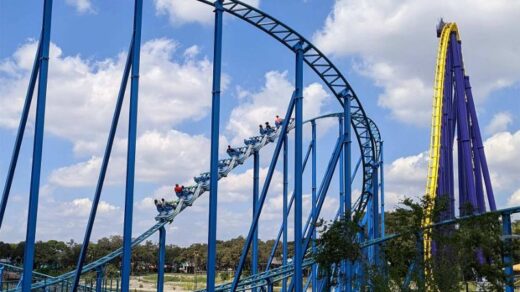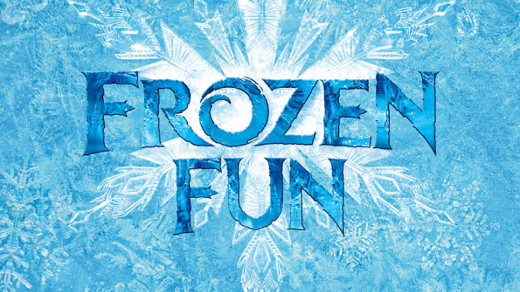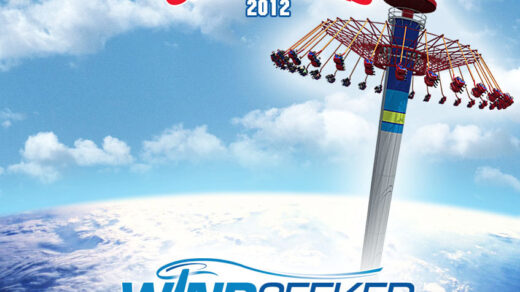Whether you’re in a park tweeting about your day, or at home, checking the Snapchat stories and Instagram posts from your favorite park, more and more parks are turning to social media to help enhance the guest experience.
We wanted to take a different approach to the “Coaster101 Roundtable” format, and instead of Coaster101.com writers giving our thoughts on social media, we reached out to several people behind the social media accounts of a few parks around the country for their thoughts on how social media and theme parks go hand in hand.
Taking part in this round table interview are:
- Nancy Chan, Communications Manager for Six Flags Discovery Kingdom
- Chris Foshee, Social Media and Digital Marketing for Carowinds
- Don Helbig, Public Relations Area Manager for Kings Island
- Rachel Jones, Marketing Coordinator for Social Media & Public Relations for Busch Gardens Tampa
- Paula Werne, Director of Communications for Holiday World
Great day to spend at #CarolinaHarbor! pic.twitter.com/98U86RfEJH
— Carowinds (@Carowinds) July 30, 2016
C101: How did you get your start in the theme park industry?
Werne: I came home one day to find a job offer from Bill Koch on my answering machine. (The late Bill Koch was president of Holiday World back in 1991 when I was hired.) They’d decided to start a PR department and invited me to join the team.
Foshee: I kind of just fell into it. I started right before we introduced Fury 325, so it didn’t take long for me to realize that I was in the right place.
Chan: I came from the zoo industry and Six Flags Discovery Kingdom has animals so I was hired for my animal experience.
Helbig: I had spent 18 years working in marketing, media relations and broadcasting roles in professional hockey prior to coming to Kings Island. My experience combined with my interest and passion for the amusement and theme park industry made for a smooth transition.
Jones: While earning my undergraduate degree in journalism, I worked as a public relations intern for a children’s museum and a luxury resort marketing company. After graduating from college, I worked for several theme parks in Orlando in roles ranging from operations, sales and event coordination.
Only 21 days of daily operation left for the 2016 season. #timeflies pic.twitter.com/kQseQNYuRH
— Kings Island (@KingsIslandPR) August 1, 2016
C101: In the last few years, social media has become a major part of theme park experience, how have you and your park adapted?
Foshee: I think we’ve done a good job of integrating it into the park experience and making it an important piece of our overall marketing strategy. We’ve put more focus and attention on social media, and we’ve added park-wide Wi-Fi throughout the park and recent released a new mobile app. Since social media is such a quickly evolving medium, I predict we’ll be forever adapting.
Jones: It is all about strategy. We don’t just throw anything up, there is a particular reason we are using a photo or a video. We now know our audiences and how they differ from platform to platform. We know that fans love when we post about roller coasters and our animal collections. In just a few short years, our social media portfolio has grown from one account to 12, creating an ongoing conversation about what Busch Gardens Tampa Bay represents.
Helbig: Social media has become one of the most important marketing aspects at Kings Island. Change is the only constant with social media, so it’s essential that you stay on top of the latest trends. I attend an annual social media conference in Orlando and some local conferences, watch web seminars and do a lot of reading to keep up. It’s become one of the primary ways we communicate and connect with our guests. We’ve been able to use social media to build a better relationship with our guests.
Werne: We were the first park to have our own blog and the first park to tweet. We embraced it early on and never looked back!
Chan: We started rolling out the park on the various social media platforms early on, but now have a better understanding of how the social media companies have changed their tactics regarding organic posts. Theme parks (and other businesses) must really be strategic in its targeting and timing to reach mass audiences.
It’s the last Friday of #SummerNights and one of the last days we’re open until midnight! https://t.co/j0hQhIk21F pic.twitter.com/hMpjAVmsDb
— Busch Gardens Tampa Bay (@BuschGardens) August 5, 2016
C101: How do you balance the social media content with a diverse audience ranging from families who may have never visited the park to hardcore enthusiasts?
Helbig: We’re able to find a good balance by creating content that showcases our best experiences. Families who have never visited the park want to experience what we’re showcasing and for enthusiasts, it reminds them of how much fun they had on the attractions we’re featuring.
Chan: Fortunately for our park, we have very diverse attractions, from wildlife to kids offerings to thrill rides. For our organic social media posts, we balance posting news about our animals with our thrill attractions and depending on the visual, we receive a lot of positive responses.
Werne: We look at social media as a series of conversations at a party. You change your tone slightly depending on your audience. We have a separate Facebook group for enthusiasts.
Jones: Busch Gardens Tampa Bay is fortunate to have a brand that resonates well with both first-time tourists and long-time visitors. Our messages can range from incentives for pass members to information on new rides and specific elements in the park we think guests would be interested in, which bodes well for both audiences. Plus, who doesn’t love a cute baby sloth photo?
Foshee: It’s really not that hard. Carowinds is a fun place. If something is fun you can connect with any audience. It’s all about presentation.
Have a purrrfect #InternationalCatDay! pic.twitter.com/S8ISYCiABV
— Holiday World (@HolidayWorld) August 8, 2016
C101: Is there a specific strategy you approach with your park’s social media posts and channels?
Chan: From the park level, our organic posts are made up of news or events (many times, it’s an animal’s birthday and our animal staff will celebrate with a fun treat!). What we try to post has a reason or a purpose; we often piggyback on holidays or designated days (like National Funnel Cake Day) or sometimes, we may be out taking photos that day, get a great shot and need to share it! YouTube videos take a little more time to produce; and sometimes it’s just taking our phone out to snap what’s going on in the park for Snapchat. We are also strategic with our sponsored posts, which often align with a deal, opportunity or announcement.
Jones: Every week we have a social media brainstorm meeting and strategize upcoming posts, events and park offerings. Our most important rule is representing the park holistically. For instance, you’ll never see a week of just rollercoaster pictures. It’s important to us that we mix things up with what we post, as well as make our posts engaging to our audience.
Werne: We’re family-owned and -operated, and are able to take a non-corporate approach in our storytelling and jovial/sometimes sassy tone.
Foshee: It varies depending on what’s going on at the park and what our overall goals are at the time. In general, I want to inform and entertain on a daily basis with a balanced approach.
Helbig: What I try to do is create content that does one of the following things: invites, informs, inspires, asks, celebrates and reminds. Content that people will want to share by offering first looks and behind-the-scenes views.
You should take a moment every day to just SCREAM (on or off a roller coaster). #summer pic.twitter.com/N4GWA2MjHu
— Six Flags Discovery Kingdom (@sixflagsDK) August 2, 2016
C101: Do you have any social media goals for the park?
Werne: To keep up the conversation, share fun stories, and respond to questions quickly.
Foshee: My goal is to service my “tribe,” our followers. If we stay focused on them, everything else will fall in place.
Helbig: Absolutely. Primary goals include building and strengthening our brand, drive conversations and increase our presence.
Chan: We do have goals, and it’s part of our marketing plan each year. Social media is a great communications tool to help deliver messages throughout the year and gauge reaction and response.
Jones: Besides wanting to increase our followers across all platforms, it’s also important to emphasize quality over quantity. We strive for followers who are actively participating in the conversation rather than a large quantity of passive followers who rarely interact with us. We strive to achieve this by staying relevant in what we post and keeping on top of social media trends
RT if this view never gets old. #TheBeast #KingsIsland pic.twitter.com/0T1FN3pTCq
— Kings Island (@KingsIslandPR) August 6, 2016
C101: As it relates to social media, what’s the most challenging aspect of your job?
Helbig: It’s making sure you’re up to speed with the current trends.
Jones: Social media is unique in that it is a 24/7, never-ending stream of new information, content and conversations happening, which presents its challenges.
Chan: Social media is an added responsibility that wasn’t traditionally a part of public relations or communications efforts but has become a major component. Social media requires creativity, keeping up to date with what’s going on at the park, knowing how to speak to audiences of all ages and what is posted basically represents your park and serves as an overall voice. While not challenging, it is good to remember that.
Werne: It’s 24/7.
Foshee: Time, but I think anyone can say that about anything. We can all use more time on certain projects. In addition to my other duties likes the website, the app, our newsletters, our new blog AirTime, the Caro-Bloggers blog ambassador program, our videos and various other tasks – you really have to stay on top of managing your time and resources.
Meet Yiscel! She is named after the Asociación Panamericana para la Conservación #sloth sanctuary co-founder! pic.twitter.com/k4Ka9mjwxs
— Busch Gardens Tampa Bay (@BuschGardens) June 7, 2016
C101: As it relates to social media, what’s the most rewarding aspect of your job?
Jones: Working for a theme park, which is also one of North America’s largest zoos, has allowed me to have some of the most amazing experiences. I’ve had the opportunity to meet Asian elephants up close, meet a baby sloth and even be featured in some of our social media content. Sometimes we have the luxury of just being able to hop on our dive coaster, SheiKra, or have an encounter with an echidna in the Animal Care Center- it’s those little moments that really add up.
Chan: Positive comments and lots of likes!
Foshee: My favorite part of my job is our guests. Social media doesn’t only happen behind a screen. Social media is at its best when it’s face-to-face. Whether it is seeing it’s someone’s birthday on Twitter and tracking them down and surprising them with a stuffed Snoopy or getting to meet one of your park’s biggest fans – it’s all about the people and making their day. We have the privilege of providing a unique escape for our guests, and it’s a joy to be a part of.
Helbig: Connecting with our audience, posting something that rekindles memories such as their first ride on The Beast.
Werne: Telling stories no one else could tell.
Who's 12 today? Why, Fedor and his sisters, Kisa & Nikita! Stop by Tiger Island & wish them a big #HappyBirthday! 🐯🎉 pic.twitter.com/11GkEVKMgQ
— Six Flags Discovery Kingdom (@sixflagsDK) August 7, 2016
C101: What is your favorite/the most effective form of social media to use and interact with and engage your park’s fans?
Helbig: Twitter has been our best platform to connect and interact with our guests. We can have more of a one-on-one dialogue there.
Chan: Personally, my favorite is Twitter for the park because it is so instantaneous; however, I do love Instagram because the visuals really resonates with our audience.
Foshee: I personally like Twitter, purely for the fan interaction and straight-forward format, but Instagram is great for engagement.
Werne: We just started a podcast and I love being part of it! Blogging is wonderful, too, as it is permanent in nature and helps create a detailed history of the park.
Jones: My favorite form of social media would have to be Snapchat. I love experimenting with making our posts engaging and fun while also leveraging a maximum of ten seconds to capture our audience. As far as our most effective platform, I’d have to say Facebook because of our following, as well as it being a huge source of information and resource for guest relations.
Happy Birthday balloons for children this evening! We're 70 today! pic.twitter.com/j5I9uqpabC
— Holiday World (@HolidayWorld) August 3, 2016
C101: What is something many people don’t realize about theme park social media or the people behind the accounts?
Werne: That we’re people, too. That sounds silly, but I’ve had to remind a few people over the years: “Would you want someone to talk to your mother this way?” Also, for some reason, it seems like some expect an inexperienced intern to be the person on social media. Not the case here. I’m a grandma!
Helbig: Many of the people behind the accounts are just as passionate about the park as our audience is which allows us to create content in more of an audience-centric way.
Jones: That there is a strategy around every piece of content we put on our social platforms. A lot of very smart and creative people behind our accounts!
Foshee: I think it is easy for people to have a shallow impression of social media marketing because people don’t understand what goes into it. It is a 24/7 job and requires at lot of attention and skill to do it correctly. There’s definitely a sophisticated strategy behind everything we do online. There’s a lot more than what meets the eye.
Chan: Social media is something that speaks directly to the user; and many people take what you’re saying very personally. It’s important to touch people directly but it’s good to remember that you’re speaking to a wide audience that has differences of opinion, tastes and interests. Some posts are very generic, talking about the weather, and others may tell a whole story. Sometimes, we take all day to develop that one story, photo or video to share with our fans, and in the end, even if there is not a lot of engagement or likes, we feel we’ve made a great effort and it was a good thing.
🙌🙌#ThatFridayFeeling pic.twitter.com/MXXWkQ9sFM
— Carowinds (@Carowinds) August 5, 2016
C101: What’s one piece of advice you could give to someone wanting to get into the theme park industry? (either in a social media/PR role, or just general.)
Chan: While many people who work in theme parks started out working in the park itself, public relations does take education, experience or mentoring to be qualified for this role. In addition to working with news media and knowing how to write and communicate at different levels (from business writing to crisis communication to copywriting), you need creativity, photography skills and event management to do the basics. The rest is instinctual on how best to garner news coverage, attention and awareness about your park.
It sounds like a fun job, and it is! But it is also a lot of work and understanding of the business. Social media is much different than PR because the younger generation has a great handle on what works and what doesn’t. Here, PR and social media go hand in hand.
Jones: A career in social media or public relations definitely requires a thick skin. As much as you may think you know what your followers are interested in or what you think will garner high engagement there will always be people who have a problem with what you post. Having said that, I think it is important to have those experiences, grow from them and use them as research for the creation of future content.
Foshee: For those wanting to get into a social media/PR role, the main piece of advice I could give is the write a lot, read a lot and then write some more. You have to be a good communicator and you have to be creative – reading and writing fuel that.
For those wanting to get into the theme park industry, many of our executives and managers started as seasonal employees, including of VP of Operations Jerry Helms who’s about to celebrate his 44th season in the industry. It is an amazing industry that is fun, challenging and rewarding.
Helbig: You have to have a strong interest and passion for the industry. You have to be excited about what you do and your park because if you’re not excited about it, how can you get anyone else to be?
Werne: Be sure to work at a park while in high school and college to get a feel for what you like to do (and what you don’t want to do!). It’s important that you understand the pacing and the level of commitment needed to succeed working in this industry. It isn’t for everyone – but if it’s in your blood, you’ll never leave!
##
Thanks to Nancy, Chris, Don, Rachel and Paula for their time. Be sure to check out their work on their parks’ social media channels!
Busch Gardens Tampa: Facebook| Instagram | Twitter | Snapchat
Carowinds: Blog| Facebook | Instagram | Twitter | Snapchat
Holiday World: Blog | Facebook | Instagram | Podcast | Twitter
Kings Island: Blog | Facebook| Instagram| Twitter| Snapchat
Six Flags Discovery Kingdom: Facebook | Instagram| Twitter | Snapchat














Thanks for including us – it was fun to read the responses from other parks!
Thanks for your help, Paula!